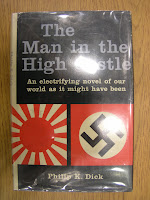It's been a busy week for me at the Lilly. I learned how to man the desk in the reading room (watch everyone like a hawk) and how to answer reference questions (which I wrote
another post about). As I mentioned last week, the Lilly does presentations to classes at IU as part of its outreach. Becky talked to quite a few classes last week, and I got to sit on one. She was talking to the Children's Lit class, and since it's a SLIS class, I knew some of the students. The Lilly has an excellent collection of children's materials. She didn't pull out the first edition Harry Potters, but she did have some of the hornbooks I picked out last week, a variety of didactic works from the 1700s, even a book called
Chaucer for Children. Given what I remember from the
Canterbury Tales, I'm not sure how I feel about sharing much of it with children. The book had annotations and footnotes and everything. It was kind of special. But Becky had also pulled out early movable books, where kids could open things or pull things or whatever. Given that they were made by hand, they were impressive. She also pulled out a modern pop-up book of the
Wizard of Oz. It was one of the most beautiful pop-up books I have ever seen. I think I enjoyed getting to see the materials as much as the students did.
The Lily is in the process of transitioning between some exhibits right now. I got to help de-install the most recent main exhibit,
Cabbages and Kings: Unexpected Treasures of the Lilly.
This meant first taking the books off of their supports so they could rest closed a little. We then went case by case, putting all of the materials in their various cases and folders (if they had them) and checking them off of the original installation list. We got to put away a variety of interesting items, including locks of George Washington's and Edgar Allen Poe's hair, a copy of
Hamlet in Klingon (taH pagh taHbe'. DaH mu'tlheghvam vIqelnIS), and two copies of the Little Red Book. I didn't get to help put away the issues of Rolling Stone or Playboy because the cases they were in required more people to open them. The next exhibit is
Gilding the Lilly, and it will be full of medieval manuscripts. Man, I love medieval manuscripts and the Lilly has a fabulous collection. I have to say that I really hope I get to help install it, but we'll see...
After learning to answer reference questions on Monday, I was tossed out by myself to see how I could do. My favorite one to work on was on Friday. We have a large John Ford manuscript collection, and I was looking to see if we had pictures of Ford and a) his wife, b) his children, and c) Katharine Hepburn. There were nine folders of photographs labeled as "friends and family" but only a small handful identified who was in them. So I first had to find out what Ford, his wife, and his children looked like. It took me most of my three hour shift to go through those nine folders. It was a lot of fun, and by then end I had a pretty good idea what his family looked like. But I didn't even get to the Katharine Hepburn ones (and I actually know what she looks like!). That's one of the things about manuscript collections. No mater how much cataloging and description you'd like to do on them, there's only so much that we have the time and resources to do. I'm sure it can get annoying to wade through folders of material to find the one item you need, but isn't that what makes research fun? At least it does to me...
A Side-note About Lilly Policy: Many people envision the everyone working with manuscripts or old books wears white gloves. There is actually a bit of debate on this in the field. The opinion at the Lilly is that gloves make it more difficult for patrons to be careful with that materials. So there are only two types of materials that receive white glove treatment: metal items and photographs. So I got to pull out the glove for the materials.
One of the perks about working with Lilly materials as a reference librarian (well, librarian-to-be) is that I get to page my own materials. The students who work at the library as pages and get materials for patrons are only allowed to page books. If patrons want manuscripts, they must be paged by one of the librarians. However, since I am working reference and retrieving my own materials, I am allowed to retrieve all of my own materials, including manuscripts. The only things I need a librarian to get are items from the Vault, and that was only an issue when I picked out the hornbooks for Becky last week.
I'm still having a blast there, and I am savoring the experience of getting to work with awesome materials in such a special library.






















